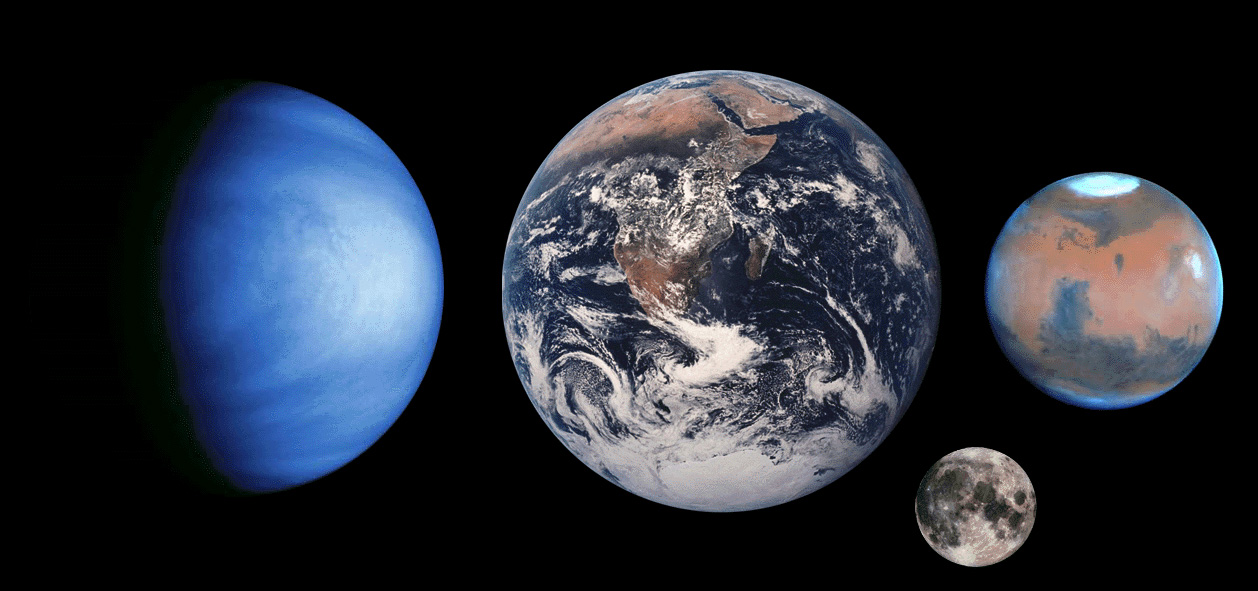Moon and Planets: Not Suitable for Settlement?

Lots of exoplanets have been discovered recently, some of which are in the “habitable zone” where water remains liquid, and more will follow. But I said no warp drives – the so called Alcubierre drive shows a way around the Einsteinian limit of speed of light (by disorting space), but seems to need exotic matter with negative mass, which may not exist and is certainly unknown at present. So the nearby solar system it is.
Attention focuses on the Moon and Mars. The former is airless, and latest indications are that although it may have some water at the poles, there is very little. The flat areas suitable for settlement total some 6 million sq.km, around two thirds of the area of the USA - useful, but not a game changer for human settlement.
Mars has more water, and an estimated 44 million sq.km of flat land - as large as Asia, where two thirds of mankind lives. Conveniently the Martian day is almost the same as Earth (although the year is much longer). However the atmosphere is so thin it is almost a vacuum – and it is far away, voyages from Earth would take months.
There is however an overriding objection to settlement in both locations – that is low gravity (17% of earth on the moon, 40% of earth on Mars). We don’t know yet the implications of living permanently in low gravity, but judging from the impact of prolonged weightlessness with astronauts, they are not likely to be good. Bone density dissolves (osteoporosis), heart expands, muscles waste away, blood pressure all over the place. On the International Space Station fit astronauts do a lot of special exercise to partly compensate for the effects of weightlessness, but one can hardly expect ordinary people to do that (how many people consistently work out at the gym, every day?). Moreover, anyone brought up in low gravity would find it difficult or well nigh impossible to adjust to 1g when visiting Earth.
The moon and Mars seem destined to be research and potentially mining sites, staffed by specialists on short term secondments, like Arctic mining camps on Earth.
An unusual possibility, though, is Venus. Not on the surface (under huge pressure from a very dense atmosphere, and hotter than molten lead) but about 50kms up in the clouds. Air pressure and temperature there means that a habitat would float if it has a normal atmosphere inside (79% nitrogen, 21% oxygen, at 1 bar). Gravity is near normal (90% of Earth), and the atmosphere protects against meteorites; it also does against cosmic radiation, although less so than on earth (no magnetic field). Temperature outside is hot, but not excessively so (~ 50-70C). The atmosphere outside is not breathable (97% CO2, the rest nitrogen laced with sulphuric acid), but nitrogen and oxygen can be extracted to create breathable air. There are two major problems, however. The habitats would be buffeted by 300-400 km/hr winds, and would circle the planet in 4 earth days (better than the 243 earth day Venusian day, I suppose). It is difficult to see how large self supporting habitats can be constructed (with room for agriculture) and it would be a scary ride. Moreover Venus’s gravity means that travelling to/from the habitats would be almost as energy intensive as going into orbit from Earth.
Source:https://www.dezeen.com/2014/12/22/nasa-explore-venus-inflatable-air-born-habitats-space-havoc/ (cropped)
Oh, and forget “terraforming” Venus. It would require the transport of impossible volumes of water, which if introduced would make the greenhouse effect even worse…
The Earth remains the only planet in the solar system suitable for sustainable human settlement. There is however another way…
Previous chapter:
Alternatives to Rockets: Skyhooks
Next chapter:
Gerard O’Neill’s Big Idea